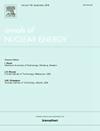An intelligent control rod movement strategy for boron-free reactor core using multi-layer perceptron machine learning model
IF 1.9
3区 工程技术
Q1 NUCLEAR SCIENCE & TECHNOLOGY
引用次数: 0
Abstract
The boron-free operation of Small Modular Reactor (SMR) core requires efficient approaches to manage excess reactivity throughout prolonged operational cycles. Adjusting Control Rods (CRs) is the only way to compensate reactivity and regulate the reactor power during the operational cycle of boron-free cores. Therefore, developing a proper CR movement strategy throughout the cycle length is crucial for boron-free cores. This study aims to apply data mining methods within machine learning approach to forecast critical CR positions at each burnup level of the boron-free core using a Multi-Layer Perceptron (MLP) model. To achieve this goal, the design of the boron-free core Control Banks (CBs) and their computations, are investigated. Furthermore, the effects of CR movement on core neutron physics parameters are considered.
The regression values for training, testing, and all datasets are calculated. The results indicate that the prediction of critical CR movement strategy is properly done by the developed MLP model. The trained MLP model operates extremely quickly (less than 1 sec) and can serve as a quick support model for forecasting CR movement strategy. The forecasting results of the developed model, based on known and unknown data, verify a high correlation between forecasted and real values, demonstrating that the performance of the developed model is good and has high accuracy.
基于多层感知器机器学习模型的无硼堆芯智能控制棒移动策略
小型模块化反应堆(SMR)堆芯的无硼运行需要有效的方法来管理整个长周期的过度反应性。在无硼堆芯运行周期内,调节控制棒是补偿反应性和调节反应堆功率的唯一途径。因此,在整个循环周期内制定适当的CR运动策略对于无硼岩心至关重要。本研究旨在应用机器学习方法中的数据挖掘方法,使用多层感知器(MLP)模型预测无硼岩心在每个燃燃水平上的关键CR位置。为了实现这一目标,对无硼核心控制库的设计和计算进行了研究。此外,还考虑了CR运动对堆芯中子物理参数的影响。计算训练、测试和所有数据集的回归值。结果表明,所建立的MLP模型能够较好地预测临界CR移动策略。训练后的MLP模型运行非常快(不到1秒),可以作为预测CR移动策略的快速支持模型。基于已知和未知数据的预测结果验证了预测值与实际值之间的高度相关性,表明所建立的模型性能良好,具有较高的准确性。
本文章由计算机程序翻译,如有差异,请以英文原文为准。
求助全文
约1分钟内获得全文
求助全文
来源期刊

Annals of Nuclear Energy
工程技术-核科学技术
CiteScore
4.30
自引率
21.10%
发文量
632
审稿时长
7.3 months
期刊介绍:
Annals of Nuclear Energy provides an international medium for the communication of original research, ideas and developments in all areas of the field of nuclear energy science and technology. Its scope embraces nuclear fuel reserves, fuel cycles and cost, materials, processing, system and component technology (fission only), design and optimization, direct conversion of nuclear energy sources, environmental control, reactor physics, heat transfer and fluid dynamics, structural analysis, fuel management, future developments, nuclear fuel and safety, nuclear aerosol, neutron physics, computer technology (both software and hardware), risk assessment, radioactive waste disposal and reactor thermal hydraulics. Papers submitted to Annals need to demonstrate a clear link to nuclear power generation/nuclear engineering. Papers which deal with pure nuclear physics, pure health physics, imaging, or attenuation and shielding properties of concretes and various geological materials are not within the scope of the journal. Also, papers that deal with policy or economics are not within the scope of the journal.
 求助内容:
求助内容: 应助结果提醒方式:
应助结果提醒方式:


